stop start RENAULT TWINGO 2012 2.G Owners Manual
[x] Cancel search | Manufacturer: RENAULT, Model Year: 2012, Model line: TWINGO, Model: RENAULT TWINGO 2012 2.GPages: 220, PDF Size: 6.73 MB
Page 12 of 220
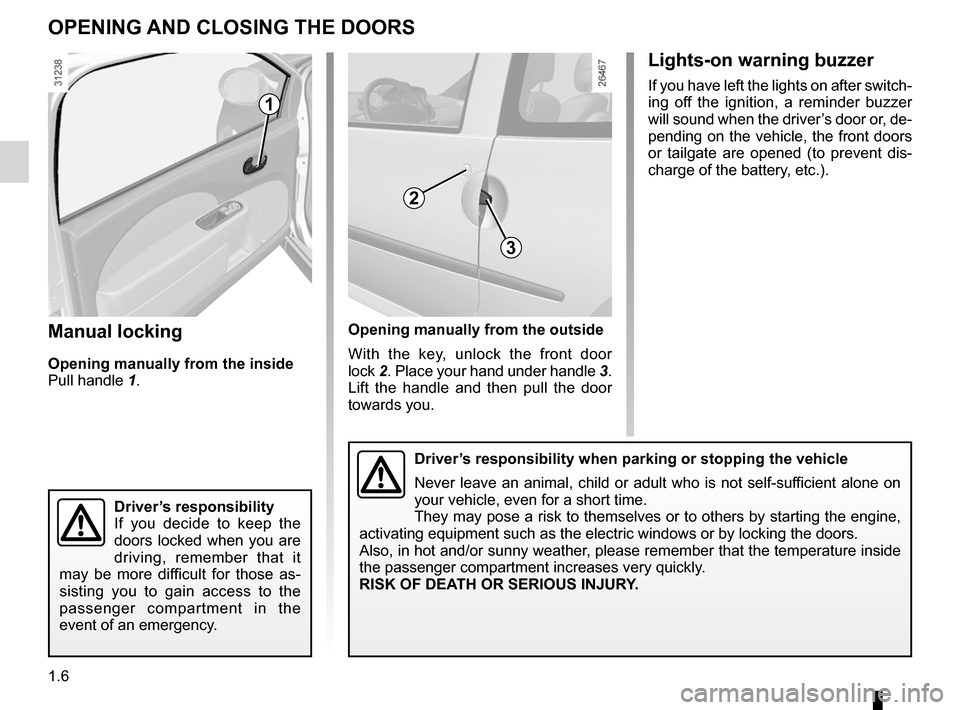
locking the doors .................................. (up to the end of the DU)
doors ..................................................... (up to the end of the DU)
1.6
ENG_UD19700_4
Verrouillage / DĂ©verrouillage des portes (X44 - Renault)
ENG_NU_952-4_X44_Renault_1
Jaune NoirNoir texte
Doors
OpENING AND CLOsING ThE DOORs
Manual locking
Opening manually from the inside
Pull handle 1.
Lights-on warning buzzer
If you have left the lights on after switch-
ing off the ignition, a reminder buzzer
will sound when the driver’s door or, de-
pending on the vehicle, the front doors
or tailgate are opened (to prevent dis -
charge of the battery, etc.).
Opening manually from the outside
With the key, unlock the front door
lock 2. Place your hand under handle 3.
Lift the handle and then pull the door
towards you.
Driver’s responsibility
If you decide to keep the
doors locked when you are
driving, remember that it
may be more difficult for those as -
sisting you to gain access to the
passenger compartment in the
event of an emergency.
1
2
3
Driver’s responsibility when parking or stopping the vehicle
Never leave an animal, child or adult who is not self-sufficient alone on
your vehicle, even for a short time.
They may pose a risk to themselves or to others by starting the engine,
activating equipment such as the electric windows or by locking the door\
s.
Also, in hot and/or sunny weather, please remember that the temperature inside
the passenger compartment increases very quickly.
RIsK OF DEATh OR sERIOUs INJURY.
Page 32 of 220
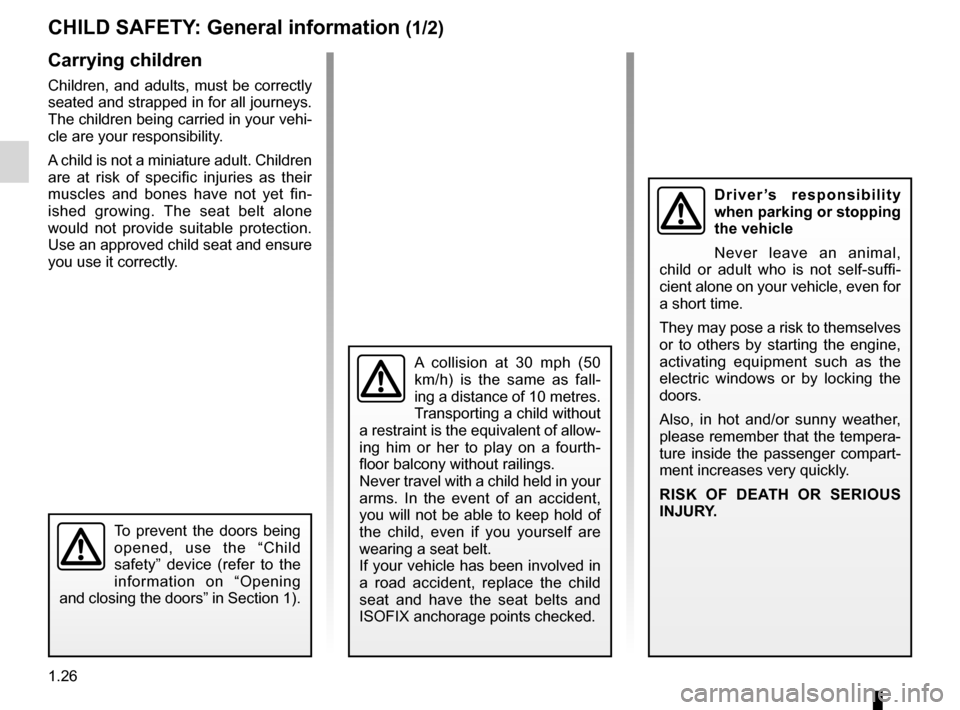
child safety............................................ (up to the end of the DU)
child restraint/seat ................................ (up to the end of the DU)
child restraint/seat ................................ (up to the end of the DU)
child restraint/seat ................................ (up to the end of the DU)
child seats ............................................. (up to the end of the DU)
transporting children ............................. (up to the end of the DU)
children ................................................. (up to the end of the DU)
1.26
ENG_UD20118_2
Sécurité enfants : généralités (X44 - Renault)
ENG_NU_952-4_X44_Renault_1
Jaune NoirNoir texte
Carrying children
Children, and adults, must be correctly
seated and strapped in for all journeys.
The children being carried in your vehi-
cle are your responsibility.
A child is not a miniature adult. Children
are at risk of specific injuries as their
muscles and bones have not yet fin -
ished growing. The seat belt alone
would not provide suitable protection.
Use an approved child seat and ensure
you use it correctly.
Child safety: General information
ChILD sAFETY : General information (1/2)
To prevent the doors being
opened, use the “Child
safety” device (refer to the
information on “Opening
and closing the doors” in Section 1).
A collision at 30 mph (50
km/h) is the same as fall -
ing a distance of 10 metres.
Transporting a child without
a restraint is the equivalent of allow-
ing him or her to play on a fourth -
floor balcony without railings.
Never travel with a child held in your
arms. In the event of an accident,
you will not be able to keep hold of
the child, even if you yourself are
wearing a seat belt.
If your vehicle has been involved in
a road accident, replace the child
seat and have the seat belts and
ISOFIX anchorage points checked.
D r i v e r ’s r e s p o n s i b i l i t y
when parking or stopping
the vehicle
Never leave an animal,
child or adult who is not self-suffi -
cient alone on your vehicle, even for
a short time.
They may pose a risk to themselves
or to others by starting the engine,
activating equipment such as the
electric windows or by locking the
doors.
Also, in hot and/or sunny weather,
please remember that the tempera-
ture inside the passenger compart-
ment increases very quickly.
RI sK OF DEAT h OR sERIOU s
INJURY.
Page 50 of 220
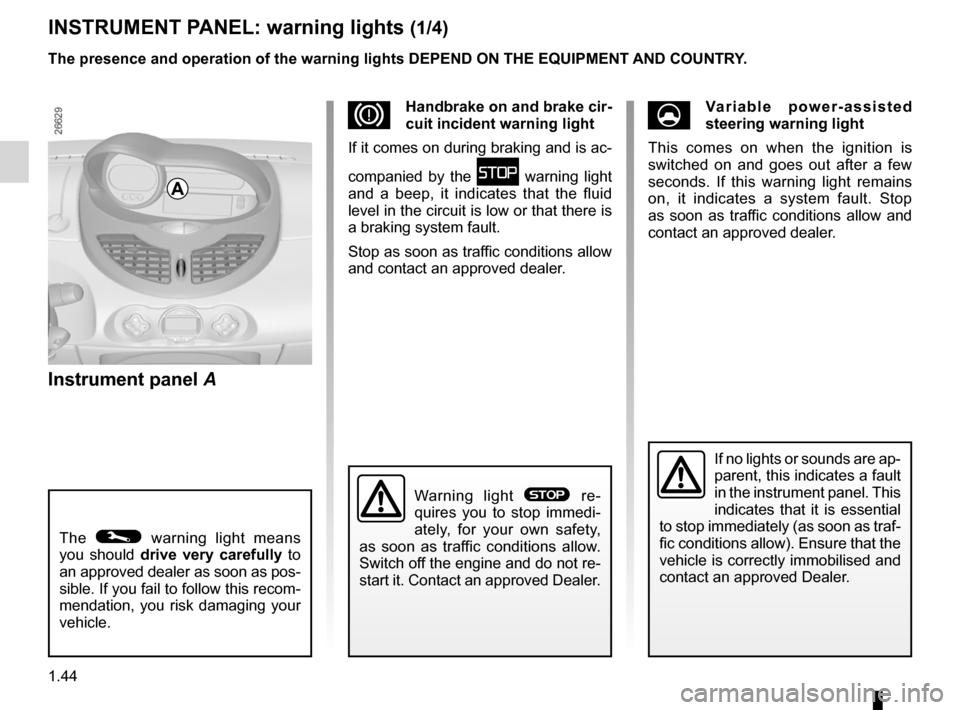
controls ................................................. (up to the end of the DU)
instrument panel ................................... (up to the end of the DU)
warning lights ........................................ (up to the end of the DU)
1.44
ENG_UD30823_8
Tableau de bord : témoins lumineux (X44 - Renault)
ENG_NU_952-4_X44_Renault_1
Jaune NoirNoir texte
Instrument panel
INsTRUMENT p ANEL: warning lights (1/4)
Dhandbrake on and brake cir-
cuit incident warning light
If it comes on during braking and is ac-
companied by the
Ă» warning light
and a beep, it indicates that the fluid
level in the circuit is low or that there is
a braking system fault.
Stop as soon as traffic conditions allow
and contact an approved dealer.
UVa r i a b l e p o w e r - a s s i s t e d
steering warning light
This comes on when the ignition is
switched on and goes out after a few
seconds. If this warning light remains
on, it indicates a system fault. Stop
as soon as traffic conditions allow and
contact an approved dealer.
If no lights or sounds are ap-
parent, this indicates a fault
in the instrument panel. This
indicates that it is essential
to stop immediately (as soon as traf-
fic conditions allow). Ensure that the
vehicle is correctly immobilised and
contact an approved Dealer.
The © warning light means
you should drive very carefully to
an approved dealer as soon as pos-
sible. If you fail to follow this recom-
mendation, you risk damaging your
vehicle.
Warning light ® re -
quires you to stop immedi -
ately, for your own safety,
as soon as traffic conditions allow.
Switch off the engine and do not re-
start it. Contact an approved Dealer.
Instrument panel A
A
The presence and operation of the warning lights DEpEND ON ThE EQUIpMENT AND COUNTRY.
Page 52 of 220
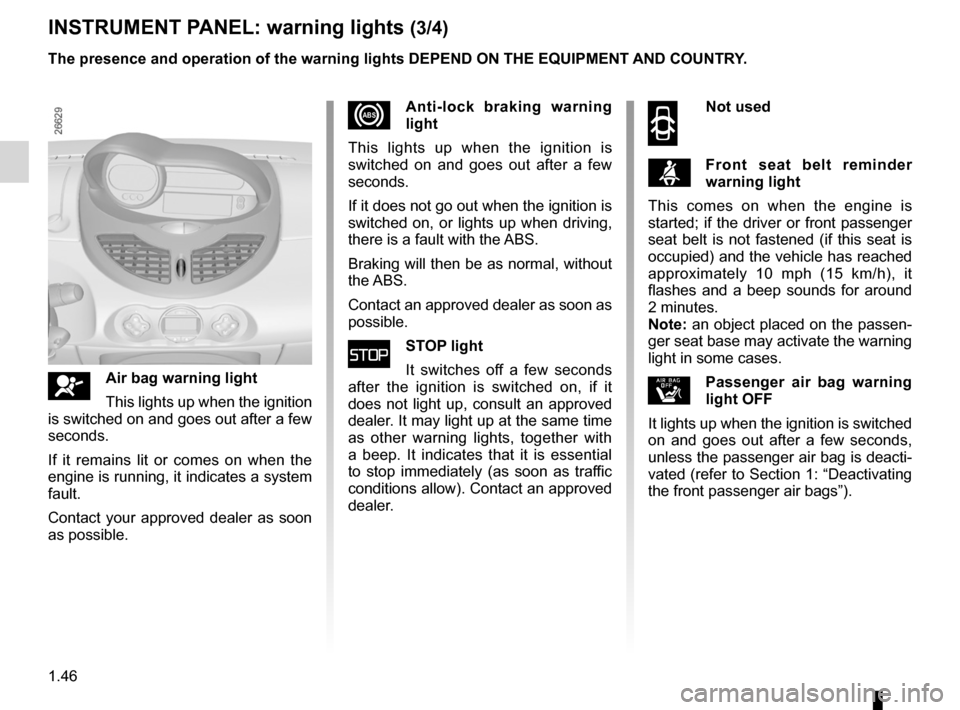
1.46
ENG_UD30823_8
Tableau de bord : témoins lumineux (X44 - Renault)
ENG_NU_952-4_X44_Renault_1
Jaune NoirNoir texte
2
Not used
ĂźFront seat belt reminder
warning light
This comes on when the engine is
started; if the driver or front passenger
seat belt is not fastened (if this seat is
occupied) and the vehicle has reached
approximately 10 mph (15 km/h), it
flashes and a beep sounds for around
2 minutes.
Note: an object placed on the passen-
ger seat base may activate the warning
light in some cases.
ĂŁp assenger air bag warning
light OFF
It lights up when the ignition is switched
on and goes out after a few seconds,
unless the passenger air bag is deacti-
vated (refer to Section 1: “Deactivating
the front passenger air bags”).
INsTRUMENT p ANEL: warning lights (3/4)
ĂĄAir bag warning light
This lights up when the ignition
is switched on and goes out after a few
seconds.
If it remains lit or comes on when the
engine is running, it indicates a system
fault.
Contact your approved dealer as soon
as possible.
xAnti-lock braking warning
light
This lights up when the ignition is
switched on and goes out after a few
seconds.
If it does not go out when the ignition is
switched on, or lights up when driving,
there is a fault with the ABS.
Braking will then be as normal, without
the ABS.
Contact an approved dealer as soon as
possible.
ûsTOp light
It switches off a few seconds
after the ignition is switched on, if it
does not light up, consult an approved
dealer. It may light up at the same time
as other warning lights, together with
a beep. It indicates that it is essential
to stop immediately (as soon as traffic
conditions allow). Contact an approved
dealer.
The presence and operation of the warning lights DEpEND ON ThE EQUIpMENT AND COUNTRY.
Page 53 of 220

JauneNoirNoir texte
1.47
ENG_UD30823_8
Tableau de bord : témoins lumineux (X44 - Renault)
ENG_NU_952-4_X44_Renault_1
uside light tell-tale light
kDipped beam headlight tell-
tale light
áMain beam headlight tell-tale
light
Ă’s equential gearbox elec -
tronic fault warning light or
water in the diesel warning light
This light flashes when the ignition is
switched on (without engine running).
It is then continuously lit for a few sec-
onds before going out again.
If it comes on when driving, it indicates
a fault in the injection computer or the
sequential gearbox, or the presence of
water in the diesel.
Contact your approved dealer as soon
as possible.
INsTRUMENT p ANEL: warning lights (4/4)
dDirection indicator tell-tale
light
gFront fog light tell-tale light
fRear fog light telltale light
\[Fuel economy indica -
tor light
Please refer to the information on “Help
with fuel economy” in Section 2.
©Warning light
This lights up when the igni -
tion is switched on and goes out after a
few seconds. It may come on with other
warning lights on the instrument panel.
If it lights up when the vehicle is being
driven, it is advisable to stop at an ap-
proved dealer soon.
ĂŽs peed limiter and cruise
control warning light
To understand how this operates, refer
to the information on “Cruise control”
and “Speed limiter” in Section 2.
Épreheating warning light
(diesel version)
With the ignition on, this light comes on;
it indicates that the heater plugs are op-
erating. It goes out as soon as preheat-
ing is sufficient and the engine may be
started.
The presence and operation of the warning lights DEpEND ON ThE EQUIpMENT AND COUNTRY.
Page 73 of 220
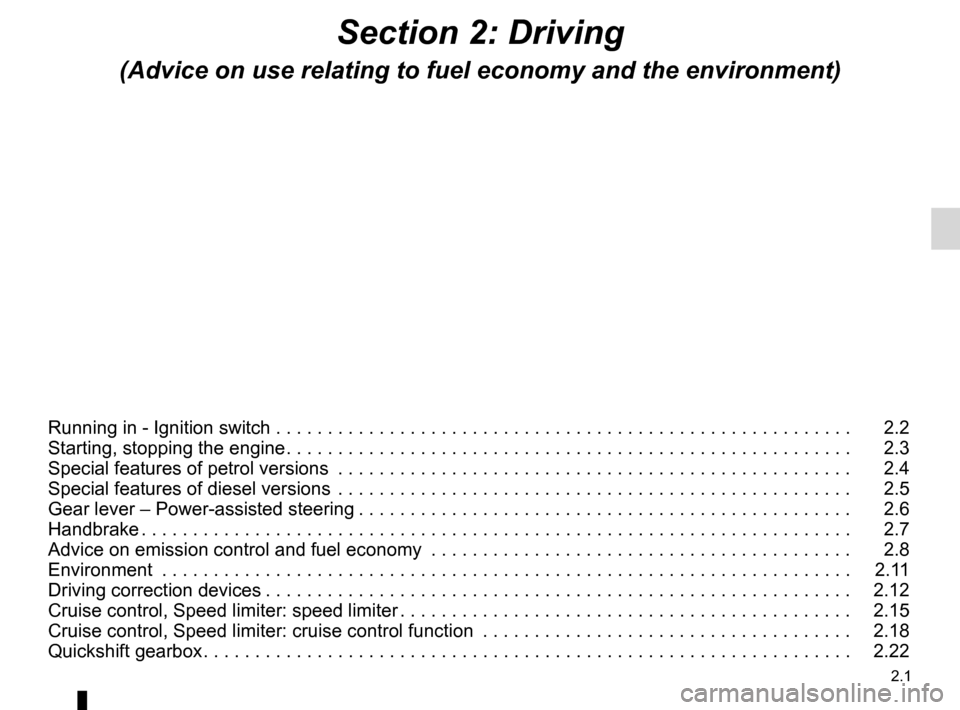
2.1
ENG_UD30794_17
Sommaire 2 (X44 - Renault)
ENG_NU_952-4_X44_Renault_2
Section 2: Driving
(Advice on use relating to fuel economy and the environment)
Running in - Ignition switch . . . . . . . . . . . . . . . . . . . . . . . . . . . . . . . . . . . . . . . . . . . . . . . . . . . . . . . . 2.2
Starting, stopping the engine . . . . . . . . . . . . . . . . . . . . . . . . . . . . . . . . . . . . . . . . . . . . . . . . . . . . . . . 2.3
Special features of petrol versions . . . . . . . . . . . . . . . . . . . . . . . . . . . . . . . . . . . . . . . . . . . . . . . . . . 2.4
Special features of diesel versions . . . . . . . . . . . . . . . . . . . . . . . . . . . . . . . . . . . . . . . . . . . . . . . . . . 2.5
Gear lever – Power-assisted steering . . . . . . . . . . . . . . . . . . . . . . . . . . . . . . . . . . . . . . . . . . . . . . . . 2.6
Handbrake . . . . . . . . . . . . . . . . . . . . . . . . . . . . . . . . . . . . . . . . . . . . . . . . . . . . . . . . . . . . . . . . . . . . . 2.7
Advice on emission control and fuel economy . . . . . . . . . . . . . . . . . . . . . . . . . . . . . . . . . . . . . . . . . 2.8
Environment . . . . . . . . . . . . . . . . . . . . . . . . . . . . . . . . . . . . . . . . . . . . . . . . . . . . . . . . . . . . . . . . . . . 2.11
Driving correction devices . . . . . . . . . . . . . . . . . . . . . . . . . . . . . . . . . . . . . . . . . . . . . . . . . . . . . . . . . 2.12
Cruise control, Speed limiter: speed limiter . . . . . . . . . . . . . . . . . . . . . . . . . . . . . . . . . . . . . . . . . . . . 2.15
Cruise control, Speed limiter: cruise control function . . . . . . . . . . . . . . . . . . . . . . . . . . . . . . . . . . . . 2.18
Quickshift gearbox . . . . . . . . . . . . . . . . . . . . . . . . . . . . . . . . . . . . . . . . . . . . . . . . . . . . . . . . . . . . . . . 2.22
Page 74 of 220
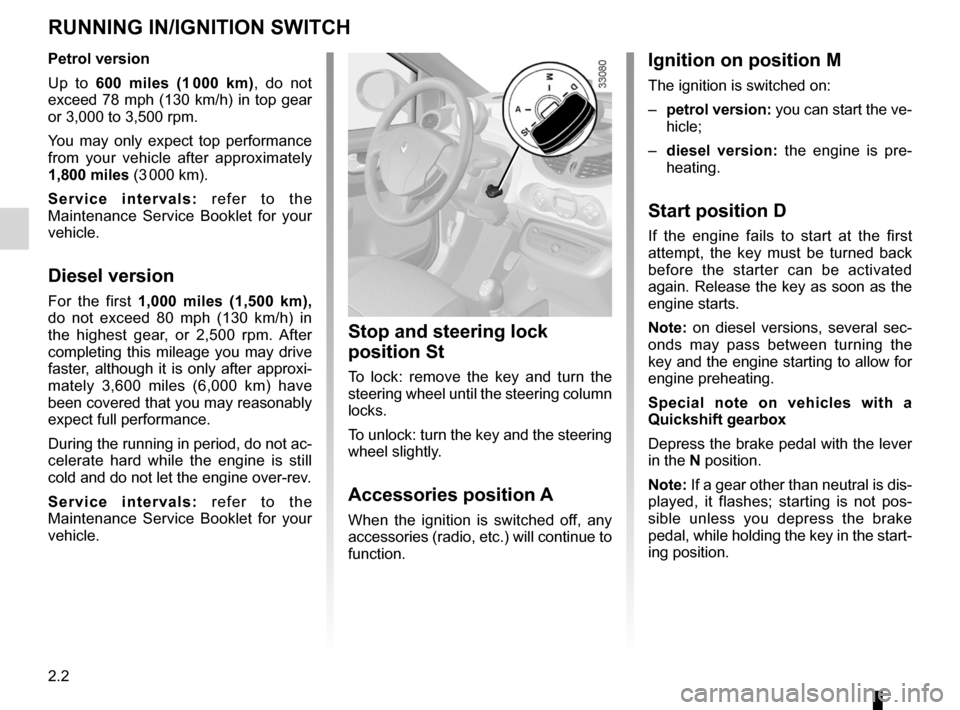
engine immobiliser (switch) .................. (up to the end of the DU)
ignition switch ....................................... (up to the end of the DU)
starting the engine ................................ (up to the end of the DU)
running in .............................................. (up to the end of the DU)
driving ................................................... (up to the end of the DU)
2.2
ENG_UD30504_4
Rodage (X44 - Renault)
ENG_NU_952-4_X44_Renault_2
Running in - Ignition switch
Petrol version
Up to 600 miles (1 000 km) , do not
exceed 78 mph (130 km/h) in top gear
or 3,000 to 3,500 rpm.
You may only expect top performance
from your vehicle after approximately
1,800 miles (3 000 km).
S e r v i c e i n t e r v a l s : r e f e r t o t h e
Maintenance Service Booklet for your
vehicle.
Diesel version
For the first 1,000 miles (1,500 km),
do not exceed 80 mph (130 km/h) in
the highest gear, or 2,500 rpm. After
completing this mileage you may drive
faster, although it is only after approxi -
mately 3,600 miles (6,000 km) have
been covered that you may reasonably
expect full performance.
During the running in period, do not ac-
celerate hard while the engine is still
cold and do not let the engine over-rev.
S e r v i c e i n t e r v a l s : r e f e r t o t h e
Maintenance Service Booklet for your
vehicle.
RUNNING IN/IGNItIoN SwItch
Stop and steering lock
position St
To lock: remove the key and turn the
steering wheel until the steering column
locks.
To unlock: turn the key and the steering
wheel slightly.
Accessories position A
When the ignition is switched off, any
accessories (radio, etc.) will continue to
function.
Ignition on position M
The ignition is switched on:
– petrol version: you can start the ve-
hicle;
– diesel version: the engine is pre -
heating.
Start position D
If the engine fails to start at the first
attempt, the key must be turned back
before the starter can be activated
again. Release the key as soon as the
engine starts.
Note: on diesel versions, several sec -
onds may pass between turning the
key and the engine starting to allow for
engine preheating.
Special note on vehicles with a
Quickshift gearbox
Depress the brake pedal with the lever
in the N position.
Note: If a gear other than neutral is dis-
played, it flashes; starting is not pos -
sible unless you depress the brake
pedal, while holding the key in the start-
ing position.
Page 75 of 220
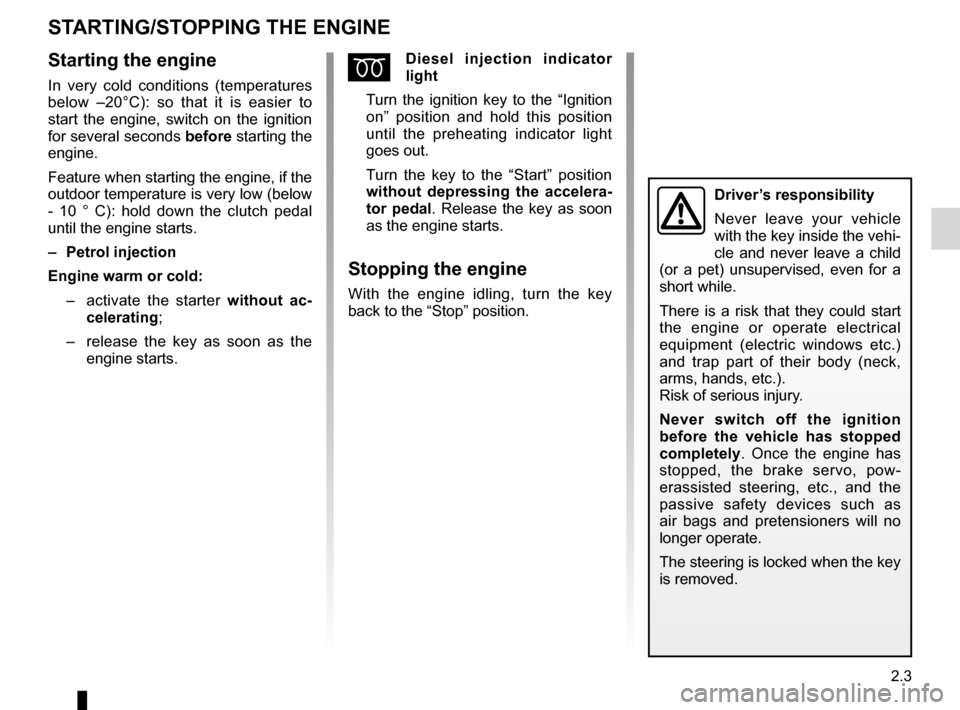
starting the engine ................................ (up to the end of the DU)
starting the engine ................................ (up to the end of the DU)
stopping the engine ............................................... (current page)
2.3
ENG_UD28739_4
DĂ©marrage / ArrĂŞt du moteur (X44 - Renault)
ENG_NU_952-4_X44_Renault_2
Starting, Stopping the engine
St ARtING/StoPPING the eNGINe
Starting the engine
In very cold conditions (temperatures
below –20°C): so that it is easier to
start the engine, switch on the ignition
for several seconds before starting the
engine.
Feature when starting the engine, if the
outdoor temperature is very low (below
- 10 ° C): hold down the clutch pedal
until the engine starts.
– Petrol injection
engine warm or cold:
– activate the starter without ac-
celerating;
– release the key as soon as the
engine starts.ÉDiesel injection indicator
light
Turn the ignition key to the “Ignition
on” position and hold this position
until the preheating indicator light
goes out.
Turn the key to the “Start” position
without depressing the accelera -
tor pedal. Release the key as soon
as the engine starts.
Stopping the engine
With the engine idling, turn the key
back to the “Stop” position.
Driver’s responsibility
Never leave your vehicle
with the key inside the vehi-
cle and never leave a child
(or a pet) unsupervised, even for a
short while.
There is a risk that they could start
the engine or operate electrical
equipment (electric windows etc.)
and trap part of their body (neck,
arms, hands, etc.).
Risk of serious injury.
Never switch off the ignition
before the vehicle has stopped
completely . Once the engine has
stopped, the brake servo, pow -
erassisted steering, etc., and the
passive safety devices such as
air bags and pretensioners will no
longer operate.
The steering is locked when the key
is removed.
Page 81 of 220
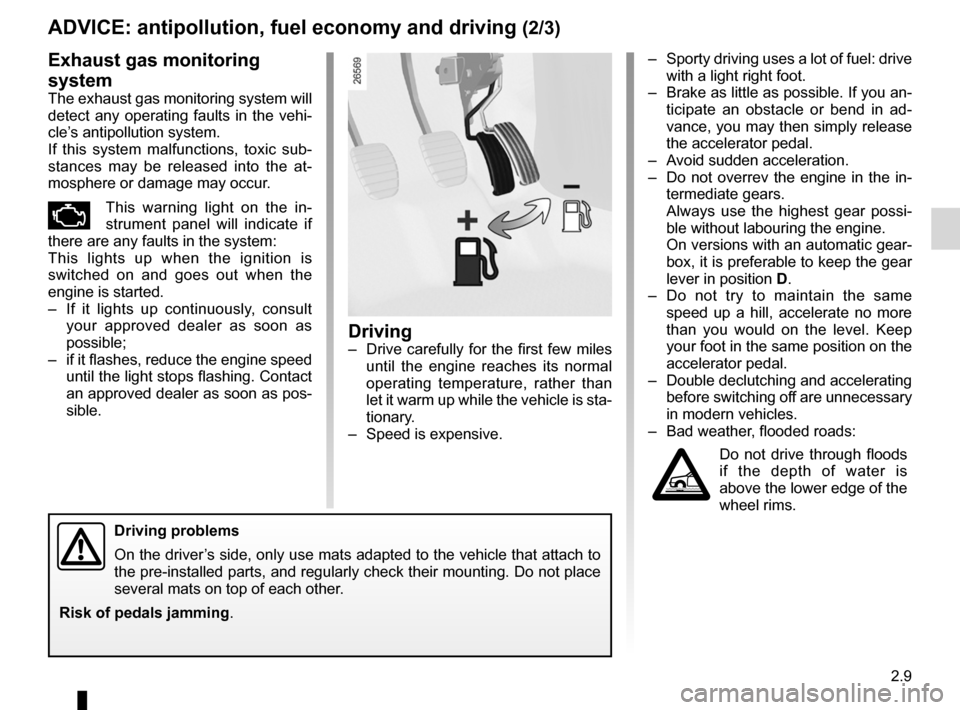
JauneNoirNoir texte
2.9
ENG_UD27029_5
Conseils antipollution, Ă©conomies de carburant, conduite (X44 - E33 - Renault)
ENG_NU_952-4_X44_Renault_2
ADvIce: antipollution, fuel economy and driving (2/3)
Driving
– Drive carefully for the first few miles
until the engine reaches its normal
operating temperature, rather than
let it warm up while the vehicle is sta-
tionary.
– Speed is expensive.
exhaust gas monitoring
system
The exhaust gas monitoring system will
detect any operating faults in the vehi-
cle’s antipollution system.
If this system malfunctions, toxic sub -
stances may be released into the at -
mosphere or damage may occur.
Ă„This warning light on the in -
strument panel will indicate if
there are any faults in the system:
This lights up when the ignition is
switched on and goes out when the
engine is started.
– If it lights up continuously, consult
your approved dealer as soon as
possible;
– if it flashes, reduce the engine speed
until the light stops flashing. Contact
an approved dealer as soon as pos-
sible. –
Sporty driving uses a lot of fuel: drive
with a light right foot.
– Brake as little as possible. If you an-
ticipate an obstacle or bend in ad -
vance, you may then simply release
the accelerator pedal.
– Avoid sudden acceleration.
– Do not overrev the engine in the in-
termediate gears.
Always use the highest gear possi -
ble without labouring the engine.
On versions with an automatic gear-
box, it is preferable to keep the gear
lever in position D.
– Do not try to maintain the same
speed up a hill, accelerate no more
than you would on the level. Keep
your foot in the same position on the
accelerator pedal.
– Double declutching and accelerating
before switching off are unnecessary
in modern vehicles.
– Bad weather, flooded roads:
Do not drive through floods
if the depth of water is
above the lower edge of the
wheel rims.
Driving problems
On the driver’s side, only use mats adapted to the vehicle that attach to
the pre-installed parts, and regularly check their mounting. Do not place
several mats on top of each other.
Risk of pedals jamming .
Page 109 of 220
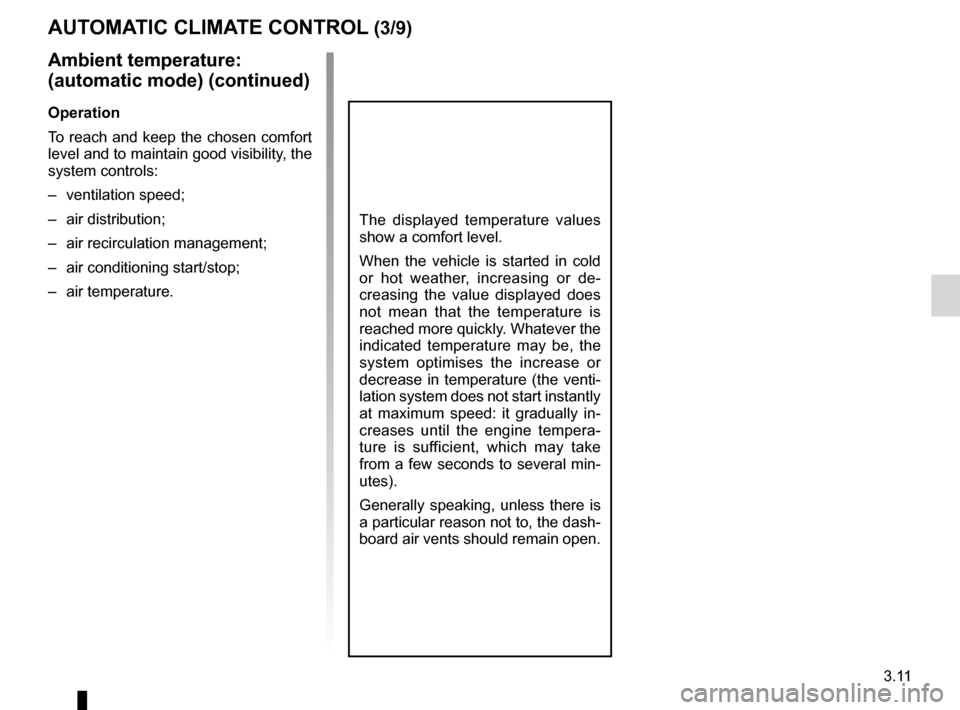
JauneNoirNoir texte
3.11
ENG_UD24164_1
Air conditionné automatique (X44 - Renault)
ENG_NU_952-4_X44_Renault_3
AuT oMATIC ClIMATE CoNTRol (3/9)
Ambient temperature:
(automatic mode) (continued)
operation
To reach and keep the chosen comfort
level and to maintain good visibility, the
system controls:
– ventilation speed;
– air distribution;
– air recirculation management;
– air conditioning start/stop;
– air temperature.
The displayed temperature values
show a comfort level.
When the vehicle is started in cold
or hot weather, increasing or de -
creasing the value displayed does
not mean that the temperature is
reached more quickly. Whatever the
indicated temperature may be, the
system optimises the increase or
decrease in temperature (the venti-
lation system does not start instantly
at maximum speed: it gradually in -
creases until the engine tempera -
ture is sufficient, which may take
from a few seconds to several min-
utes).
Generally speaking, unless there is
a particular reason not to, the dash-
board air vents should remain open.